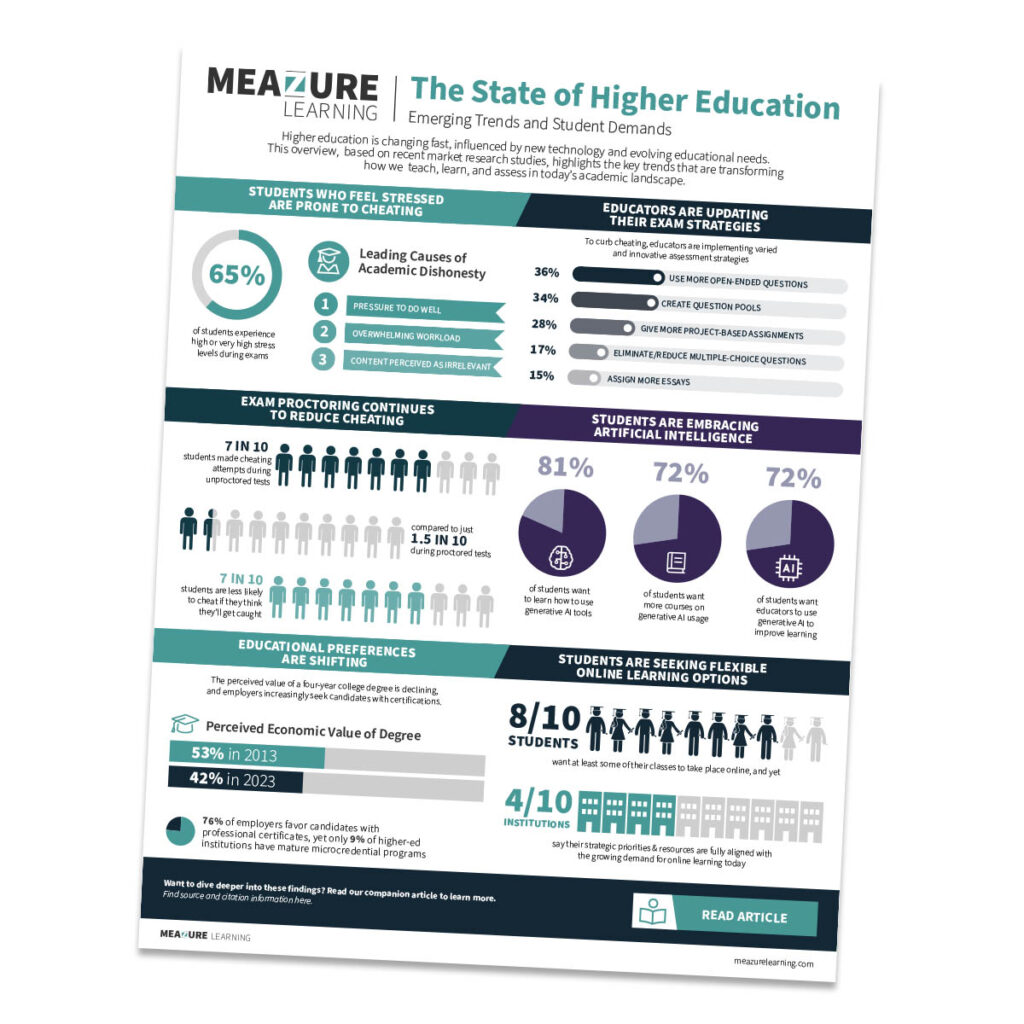Higher education is at an inflection point. New technologies, shifting student expectations, and evolving workforce needs are changing how we teach, learn, and assess at the postsecondary level. The decisions made in response to these changes will shape the direction of higher education for years to come.
As a companion piece to our in-depth article, this data-driven infographic presents key findings from recent market research studies about the current state of higher education. By aggregating these findings, this resource offers a snapshot of the latest and most significant trends, challenges, and opportunities for higher-ed institutions.
Download this infographic to find:
- Insights into Academic Pressure & Integrity: Understand the stress levels and factors contributing to academic dishonesty.
- Innovative Strategies to Curb Cheating: Explore how educators are adjusting their exam methods to promote academic honesty.
- Data on Proctoring Effectiveness: Learn about the impact of exam proctoring on reducing cheating incidents.
- Student Preferences for Digital Learning: Discover student inclinations toward online learning and the digital readiness of institutions.
- Perspectives on Alternative Education Paths: Gain insight into the shifting preferences among students and employers for college degrees vs. professional certificates.
- Student Views on AI: See how students perceive the use of AI in their education.
Are you ready to adapt to the changing landscape of higher education?
Source List
Wiley, “New Insights Into Academic Integrity: 2022 Update” (PDF file, 2023), https://www.wileyplus.com/wp-content/uploads/2023/05/academic-integrity-infographic-Wiley.pdf
Turnitin, “Student and Faculty Survey: Perceptions of Assessment and Academic Integrity” (PDF file, 2022), https://www.turnitin.com/infographics/insights-survey
Pleasants, J., Pleasants, J. M., & Pleasants B. P. (2021). Cheating on unproctored online exams: Prevalence, mitigation measures, and effects on exam performance. Online Learning, 26(1), 268- 284. DOI: 10.24059/olj.v26i1.2620
Anthology, “Comparing Global University Mindsets and Student Expectations: Closing the Gap to Create the Ideal Learner Experience” (PDF file, 2022), https://www.anthology.com/sites/default/files/2022-06/UNESCO-Anthology-Whitepaper-v1.5.pdf
Quality Matters and Encoura Eduventures Research, “CHLOE 8: Student Demand Moves Higher Ed Toward a Multi-Modal Future: The Changing Landscape of Online Education,” (PDF file, 2023), https://qualitymatters.org/sites/default/files/research-docs-pdfs/QM-Eduventures-CHLOE-8-Report-2023.pdf
Inside Higher Ed, “Majority of Americans Lack Confidence in Value of 4-Year Degree,” (2023), https://www.insidehighered.com/news/2023/04/03/majority-americans-lack-confidence-value-four-year-degree
EDUCAUSE and WICHE Cooperative for Educational Technologies, “EDUCAUSE and WCET QuickPoll Results: Current Trends in Microcredential Design and Delivery,” (2023), https://er.educause.edu/articles/2023/5/educause-and-wcet-quickpoll-results-current-trends-in-microcredential-design-and-delivery#fn2
KPMG in Canada, “Despite popularity, six in 10 students consider generative AI cheating,” (2023), https://kpmg.com/ca/en/home/media/press-releases/2023/08/six-in-ten-students-consider-generative-ai-cheating.html
